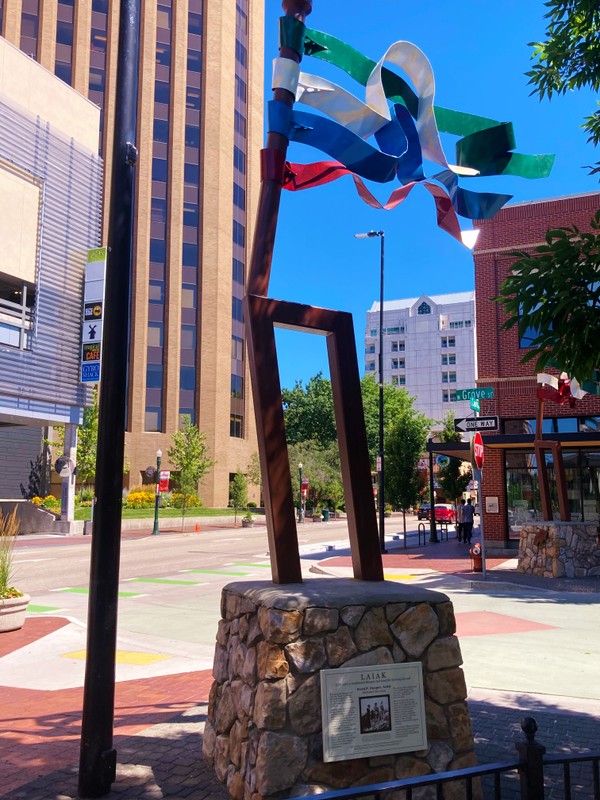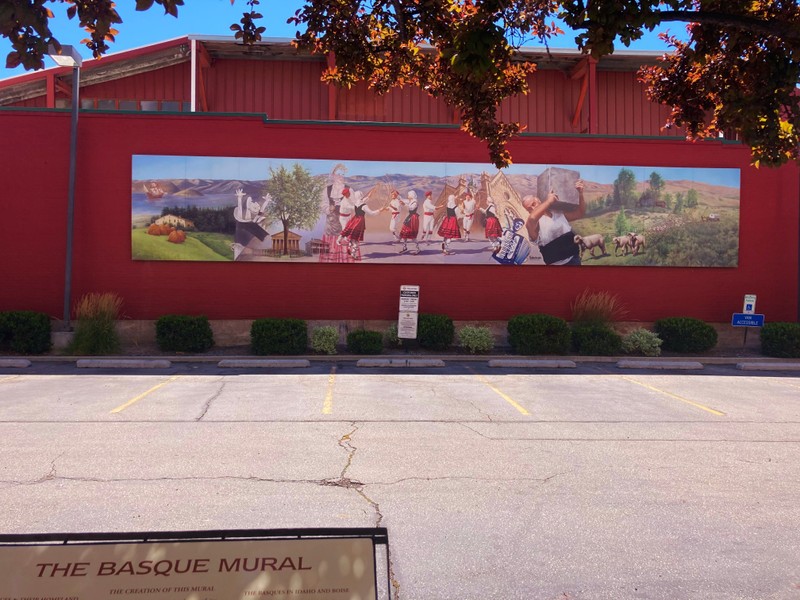The Basque Mural and Laiak Sculptures
Introduction
Text-to-speech Audio
Images
Laiak Sculpture

Basque Mural

Backstory and Context
Text-to-speech Audio
Boise’s Basque block, on Grove Street between S. 5th and Capital Blvd, has had a long history of occupation by Basque immigrants since the early 1900s. The purpose of the Basque Block and its many businesses and organizations is to preserve Basque culture in Boise and educate others on the history of the population in Idaho. As a part of this mission, public art located on the block serves to outwardly express Basque Culture through a visual medium. Both built in 2000, the Basque Mural and Laiak Sculpture function to educate viewers on Basque tradition and heritage.
Displayed on the back side of the Anduiza Fronton, facing Capital Blvd., the Basque mural is a 48 ft long painting depicting Basque culture in Boise and its ties to the Basque country. The mural was painted for the city of Boise by the Letterheads, an international sign painting group, and Noel Weber, a Boise sign artist, during their 25th annual convention. After gathering information regarding Basque culture from local sheepherders and the community, the mural was completed in 3 days with the help of several volunteers. Images depicted in the painting include ships sailing to the America’s, Boise’s Oinkari Basque Dancers, the “Tree of Gernika”, a desert sheep camp, the Boise foothills, St. John’s Cathedral, the Star Boarding house, Jimmy Jausoro playing the accordion, and Jose Luis Arrieta lifting a rock weight. These images capture the highlights of Basque identity and tradition, while educating the community about the culture as well.
Just up the street from the Basque mural, is the Laiak Sculpture located on the corner of Grove St. and Capital Blvd. There is a second matching sculpture located at the end of the Basque block as well, closer to S. 5th Street. Also built in 2000, the metal sculptures created by Ward Hooper depict a laiak which is a traditional agricultural tool used by the Basques to turn soil. On the handle portion of the laiak are seven flying ribbons which are meant to represent the seven historic provinces of the Basque country. Located on the stone base of the sculpture is an educational plaque printed in both English and Basque, telling the story of the Basques and the symbolism of the sculpture.
Both the Basque Mural and the Laiak Sculpture have been valuable additions to Boise’s public art scene and to the Basque block. Not only are they beautifully crafted works, but they also contribute to the education of the community and preservation of Basque culture in Boise.
Cite This Entry
Kristina Cockerille on behalf of Basque Museum & Cultural Center. "The Basque Mural and Laiak Sculptures." Clio: Your Guide to History. July 13, 2020. Accessed April 3, 2025. https://theclio.com/entry/109351
Sources
Mackey, Meggan Laxalt. Lekuak: The Basque Places of Boise, Idaho. Edition 1. Reno, Nevada. Center for Basque Studies Press, 2018.
Hill, Gretchen (2014) "Production of Heritage: The Basque Block in Boise, Idaho," BOGA: Basque Studies Consortium Journal: Vol. 1 : Iss. 2 , Article 3.
Features - The Basque Mural, The Basque Block. Accessed July 9th 2020. https://www.thebasqueblock.com/basque-mural.
Laiak Basque Block, Boise City Dept of Arts and History. Accessed July 9th 2020. https://www.boiseartsandhistory.org/explore/collections/public-art/laiak-basque-block.
Provided by Kristina Cockerille
Provided by Kristina Cockerille

